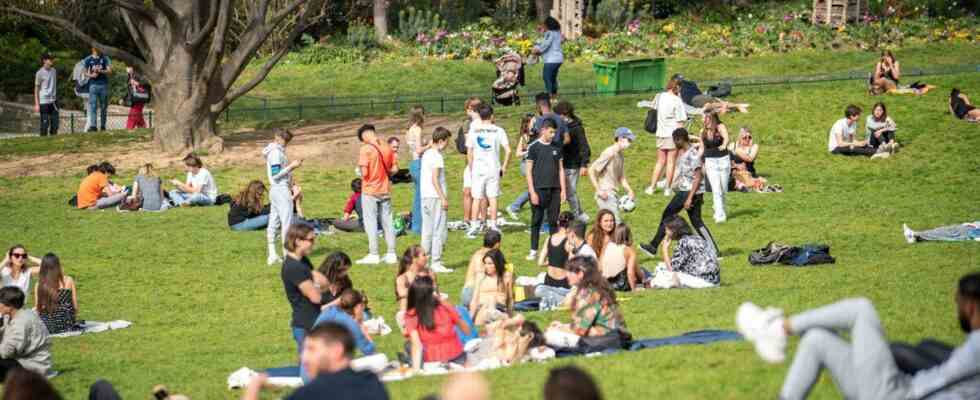It smells good in summer. It is beautiful, very beautiful. And hot, very hot. Even too much. And it will last all week. From this Wednesday, an early heat wave from the Maghreb will affect all of France, where the thermometer will panic and locally exceed 40 ° C.
If the most vulnerable must obviously stay cool and hydrated, those most eager for the sun, themselves, risk not resisting the call of well-exposed terraces, while those who work outdoors will have to reconcile professional activity and heat and sun management. A sun which, without protection, only wants good for our skin. On the occasion of the Week of Prevention and Awareness of Targeted Skin Cancer Screening, from June 12 to 17, 20 minutes reminds you of the good reflexes to adopt in town to take advantage of the virtues of the sun without suffering its misdeeds.
Same misdeeds at the beach and in town
On vacation, we are more or less good students. Beach, mountain, countryside… During the summer, many are those who adopt the right reflexes. In everyday life, on the other hand, when the sun heats up the asphalt and makes us suffocate, good habits are often forgotten. Whether it’s going to work, having a drink or simply getting around on foot, almost no one is protecting themselves. “For most people, this is only necessary on vacation. In town, it is not a subject of concern”, observes Dr. Isabelle Rousseaux, dermatologist.
However, “the sun does not make a selection: it hits everywhere, underlines Dr Marc Perrussel, dermatologist at the Pontchaillou University Hospital in Rennes and vice-president of the National union of dermatologists-venereologists (SNDV). And when you do a job outdoors or spend more time outdoors, in parks or on terraces, at the most risky hours, UV rays will unfold their harmful effects like everywhere else”. However, “exposure to UV radiation is the first cause of skin cancer”, recalls the SNDV. UVs which have “a variable presence: UVAs, responsible for skin aging, radiate all year round, when UVBs are especially present in the summer period, when we are more exposed, explains Dr. Perrussel. UVB rays which pass through pollution and will eventually cause sunburn and consume sun capital”.
Some people more at risk than others
In a homeopathic dose (15 minutes a day on the forearms), the sun has benefits for the body. It allows it to synthesize vitamin D – essential for bone health and immunity. And it must be admitted, the sun, we also love it for this golden tan it gives to the skin. But at high doses, he is no longer a friend. And in the long term, “poorly controlled exposure can have harmful consequences, which can go as far as cancer”, warns Dr. Perrussel. In particular for certain people: “we are not all equal in the face of the sun, and certain people are more at risk of developing skin cancer”, recalls the SNDV.
Are potentially at risk of melanoma “people who have fair skin, eyes and hair, who easily get sunburn and who have many moles”, explains Dr. Perrussel. Australia, where the rays are particularly harmful due to a hole in the ozone layer, and where the historic white population is of British descent, has one of the highest rates of skin cancer in the planet. However, “less frequently of course, dark skin can be at risk of melanoma”, underlines the dermatologist. In addition, “being immunocompromised, having a family or personal history of melanoma” are risk factors, completes the SNDV.
And other people are also more fragile. “All those who work outdoors, in construction, outdoor sports or in rural areas,” adds Dr. Perrussel. But also “bald people, completes Dr. Rousseaux. The scalp is very fragile, it is a very important area of cancerization”. Thus, “one of the most frequent pathologies in bald people is actinic keratosis, explains Dr. Perrussel. These are precancerous lesions which, in 10% of cases, can evolve into very virulent carcinoma, since it is a cancer which can metastasize. And which is more common than melanoma, with a frequency of about 20 people per 100,000 inhabitants, against 2 to 4 per 100,000”.
Rigorous protection and regular monitoring
To protect yourself, “we adopt in town the same reflexes as at the beach, insist the two dermatologists: we avoid the sun between 12 and 4 p.m., or we put on light but covering clothes, we wear a wide-brimmed hat to protect the top of the skull as well as the nape of the neck and the ears”. And “we avoid sunburn tattoos, drawn by sunburn”, insists Dr. Perrussel. “And we apply an index 50 sunscreen as soon as there is strong sun, every morning, even to go shopping”, prescribed Dr. Rousseaux. “In sufficient quantity,” continues Dr. Perrussel. For the neckline, for example, the right amount is the palm of your hand, no less, to be renewed every two hours. And that does not dispense with avoiding the sun at the hottest hours.
Without these precautions, “there is a risk of quickly suffering the effects of UV with sunburn, warns Dr. Perrissel. But it is pernicious and has wicked delayed effects. Ultimately, there is the risk of observing accelerated aging of the skin and the appearance of cancer, whether in urban, rural or coastal areas”. To counter UVA “responsible for aging of the skin and which pass through the windows, solar filters can be placed on buildings such as on road vehicles, for example”.
And to stay on these – new – good reflexes, “we inspect our moles regularly, checking that there are no rough, red, puffy, irregular lesions, of several colors or of large and changing diameter, advises Dr Perrissel. If necessary, you consult your attending physician who, if necessary, will relay to a dermatologist for rapid treatment”. Each year, around 100,000 skin cancers are detected in France, indicates the SNDV. And according to INCa, the number of skin cancers has more than tripled in thirty years.

